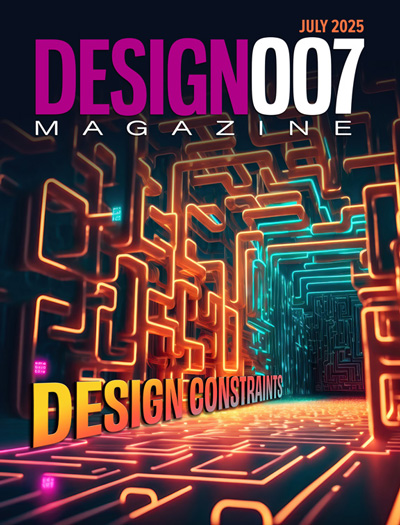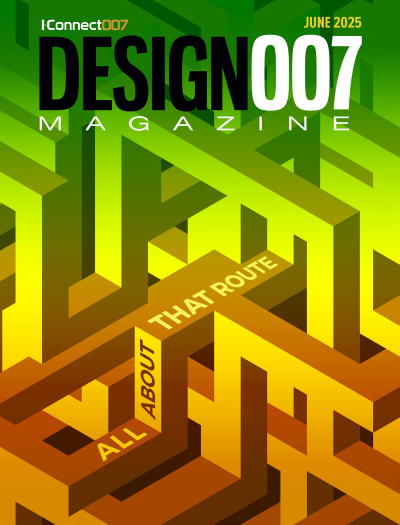-

- News
- Books
Featured Books
- design007 Magazine
Latest Issues
Current Issue
Proper Floor Planning
Floor planning decisions can make or break performance, manufacturability, and timelines. This month’s contributors weigh in with their best practices for proper floor planning and specific strategies to get it right.

Showing Some Constraint
A strong design constraint strategy carefully balances a wide range of electrical and manufacturing trade-offs. This month, we explore the key requirements, common challenges, and best practices behind building an effective constraint strategy.

All About That Route
Most designers favor manual routing, but today's interactive autorouters may be changing designers' minds by allowing users more direct control. In this issue, our expert contributors discuss a variety of manual and autorouting strategies.
- Articles
- Columns
- Links
- Media kit
||| MENU - design007 Magazine
A Look Into the Future With Futurist Kevin Surace
April 7, 2025 | Barry Matties, I-Connect007Estimated reading time: 14 minutes
Matties: Bare board fabrication has more than 300 steps. As you know, much IoT is missing. Sensors are missing, and some people are reluctant to invest in sensors, perhaps because there’s not a blueprint for them to even take the next step after a sensor.
Surace: Part of it is you want to sense and image everything that's happening so you can start to build data on things that came out good, and things that didn't. You look at things that yielded the way you wanted to and things that didn't. As you build up that database, you build a neural net; automatically, it will start to find things by itself, flag you, and indicate not to proceed because, for example, it already has a defect at the lowest layers, the electroless didn't deposit right, or whatever the case might be. You have no choice because you’re always assuming your competitor is deploying these, and their yields will be better, their costs are lower, their output is lower, and you will be left behind.
Matties: That’s when you create the ecosystem of digital twin.
Surace: Oh, everything should be done first on the digital twin. I just released another product with a digital twin that takes big enterprise applications, makes a digital twin of them, and creates tests on the digital twin before it goes back to the original application.
That is what you want to do. You want a digital twin to twiddle with because a non-digital version is hard-coded. Once the PCB is made, you can’t manipulate it, but you can manipulate the digital twin, and see how it will affect your yields if you get a little more space between this line and this via, for example, that’s causing you trouble.
Matties: If you were manufacturing boards, what would be your first step?
Surace: Outfit everything with IoT. You want images of everything. Then tie that to outcomes. It’s all you’re trying to do. When one thing runs, you get a million images, and here is the outcome. Then another thing runs, and you get a million images with another outcome. You want to build up that data so that it trains itself to recognize things earlier in the process. Again, we are trying to recognize things early so we don't waste the rest of the time and the money.
We will stop, address, and improve yields. It's true with the pick and place as well where you want to see it early. We've had vision systems there, but now we can do AI vision systems that are far superior and more accurate.
Matties: You can also manage workload balance, labor resources and talent, and schedules.
Surace: Absolutely. You should be using AI for that now. You say, “I have X number of inputs, which are people, and X number of outputs. Let the AI tell me where to put everyone.”
Matties: We saw a mass migration of work go to China because of labor costs. Labor costs aren't a factor if we embrace automation and AI.
Surace: Exactly. There will be a rash of onshoring in many countries, probably away from China. With all due respect to very good people and everything else, the Chinese government may not be the friendliest to the rest of the nations, and we must be thoughtful about that.
Matties: China took advantage of an opportunity.
Surace: Yes. The labor was 50 to 20 cents an hour. As we bring back manufacturing, we can bring it back in a highly automated fashion.
Remember, we went everywhere else in the world for a lower cost of labor. If the labor cost here in the U.S. had been a dollar an hour, we wouldn't be having this conversation. AI, robotics, and higher yield can be the equivalent of a dollar an hour. If I can make something with one-twentieth of the labor that I had before, I'm equal to any place in the world and probably even beat them.
Matties: Will we see volume manufacturing come back?
Surace: You see TSMC now committing to $100 billion in a semiconductor fab, but everything is more expensive here. Geopolitically, what choice do you have? We need to see more volume manufacturing come back onshore for military and things like that.
It's not high volume, but it's big, high-quality kinds of things. We need it for medical equipment as well. I hope we see more of it. There are shipping costs and now tariffs, so there are all kinds of things that will impact this. So, install AI and keep it close to where your customers are so you can drive those costs down by driving labor out of it.
Matties: Now you're working with a company that's doing the testing for software?
Surace: I have a company called Appvance that developed AI to find bugs in enterprise-level software. You may not know that a bank like J.P. Morgan has 15,000 applications that run their company. Those all have to be tested every day with upgrades and security updates.
They have what equates to tens of thousands of people both on and offshore that do that both manual and automated testing. AI can take it over fully and that's where we will be over the coming years. It’s a very hard technology, and Appvance is probably in the lead by several years with that technology slew of patents. AI will find more bugs in any one software than any team of people can find.
Matties: Is the job of a coder past tense now?
Surace: Depending on what you're doing with AI encoding, with copilots or whatever, you're either about 50% more productive, or it could be 90–95% more productive than you've been depending on the software, how you use it, your experience level, etc. We’ve had a longtime shortage of coders, and AI is starting to level that playing field. We still have more needs, but we won't have a shortage. AI can also be better than an entry-level coder, so we may not need as many. It's not as good as a senior architect; my senior architect is running the AI. I probably wouldn’t send my kid into coding right now. I’d probably steer them toward a trade like a plumber, HVAC, or equipment repair because all the equipment's different and it's hands-on. It's hard for robots to do these types of jobs.
Matties: What is the role of a futurist?
Surace: Well, it's very hard to predict the future. For example, if you took your iPhone, went back in time 100 years, and handed it to someone, what would they do? It's the early 1900s, there's no internet and no phone service, so the phone won’t work. Now, what if that person were asked to take it apart and reverse-engineer it? Even if they could get it apart, they wouldn’t understand how the screen works or anything about the components.
Where do they even start? They might understand the printed circuit board, but practically no way to look at it unless they’re in a chemistry lab with a microscope. Now go back just 50 years, and the iPhone would still be hard to imagine.
It's very hard to sort of be a futurist, but the role is to say, “Here's the technologies as we know them, and if we follow that technology, here’s a prediction for at least 10 years out.”
Right now, I can tell you what your future will look like: AI will be in everything you do. You will not do anything without AI next to you. You will have agents and humanoid robots at work and at home, and we will just work along with them like we work with the internet. I guarantee it.
Matties: Kevin, it was great to talk with you today, thank you so much.
Surace: You are welcome.
Page 2 of 2Testimonial
"In a year when every marketing dollar mattered, I chose to keep I-Connect007 in our 2025 plan. Their commitment to high-quality, insightful content aligns with Koh Young’s values and helps readers navigate a changing industry. "
Brent Fischthal - Koh YoungSuggested Items
Training AI Together—Without Sharing Private Data
05/21/2025 | Nolan Johnson, SMT007 MagazineArtificial intelligence models work better with more data. While individual EMS companies can certainly create plenty of data over time, the broader the data set, the more insightful the AI results can be. Ben Rachinger, a research assistant at Friedrich-Alexander-Universität Erlangen-Nürnberg, received the NextGen Best Paper at IPC APEX EXPO 2025. His research asks: What if a model could be created that allowed industry-wide data in the model, while still protecting proprietary information?
IPC Excellence in Education Award: Zenaida Valianu
05/01/2025 | Nolan Johnson, I-Connect007Zenaida Valianu is the training manager at IPC who brings more than 25 years of expertise in standards and training development to her role. She has revolutionized IPC certification training programs by significantly enhancing their content with comprehensive curricula and engaging materials. She has also been instrumental in developing essential workforce training courses and contributing to various other initiatives.
A Visit With ‘Flexperts’ Mark Finstad and Nick Koop
05/01/2025 | Joe Fjelstad, Verdant ElectronicsAt IPC APEX EXPO 2025, I chatted with seasoned flex experts Mark Finstad and Nick Koop about "Flexperts" and their roles as leading educators and in the realm of standards development for this increasingly indispensable electronic interconnection technology. They have been teaching about lessons learned and how to successfully navigate the “seas” of flexible circuits to help their students avoid the hazards that have taken down many of their predecessors in the past.
Empathetic Leadership for Incomprehensible Times
04/30/2025 | Nolan Johnson, SMT007 MagazineAudrey McGuckin and Catherine Sherman of the McGuckin Group delivered a keynote at the EMS Leadership Summit at IPC APEX EXPO 2025, emphasizing psychological safety and people-centric leadership in the EMS industry. Through personal stories, they fostered an open environment, where attendees learned about empathetic management practices. They introduced the popular BANI (Brittle, Anxious, Non-linear, Incomprehensible) model, underscoring the need for transparency and empathy in today’s complex business landscape.
New RF Materials Offer Options for RF Designers
04/29/2025 | Andy Shaughnessy, Design007 MagazineThe RF materials arena has changed quite a bit in the past decade. The newest thermoset laminates boast performance numbers that are almost competitive with PTFE, but without the manufacturability challenges. At IPC APEX EXPO this year, I spoke with Brent Mayfield, business development manager at AGC Multi Material America. Brent walked through some recent innovations in RF materials, advances in resin systems, and the many design trade-offs for RF engineers to consider for each material set.


